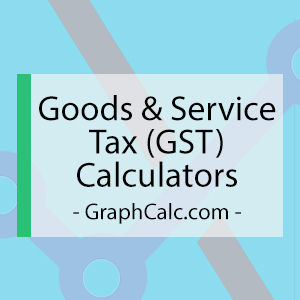Our best GST calculator computes the full price of a product including the goods and service tax that you pay when you purchase a good. This calculation uses the Net price and GST tax rate to compute both the gross price of a product as well as the tax amount on that good.

What is Good and Service Tax (GST)?
Contents
The Good and Services Tax (GST), also known as Value-Added Tax (VAT), is a percentage applied to the price of individual products and services, added to it, and paid entirely by the final consumer of the good. The tax revenue is initially gathered by the business selling the good or service and is later on transferred to the government through a tax filling. The tax is commonly paid in the point of sale (POS) and it is shown in the invoice issued by the vendor. The percentage, in most cases, is fixed for all types of products and services, yet in some instances there are either exempted goods or services, or there could also be different percentages that will apply to certain types of products.
The GST is not recorded as a revenue by the vendor as it is a tax owed to the government. Instead, it is recorded as a liability in the company’s books until the money is transferred to the government. Businesses also collect GST credits from their suppliers and they create a report (commonly at the end certain pre-defined time period) that calculates the amount in GST debits and credits, and the net result (usually positive, as vendors sell their products with an additional profit), is the amount that has to be paid to the government.
Who Uses GST?
Good and Services taxes are often employed by governments to reduce inflationary pressures. Nevertheless, they take a toll on a country’s gross domestic product, as demand often shrinks due to the higher price that consumers now have to paid due to the additional tax.
On the other hand, GSTs can also be imposed by individual states or even municipalities as a counter-measure for activities that are socially harmful such as gambling, alcohol or tobacco. These tailored GSTs tend to be above the fixed rate applicable to standard products as it aims to compensate for the damages caused by these products or services.
How to Calculate GST Formula
The GST formula calculation of the amount to be paid for the concept of GST is fairly straightforward and it goes as following:
GST = Price x % GST
The formula components are:
Price = Pre-tax price of the product or service
% GST = The percentage of tax established for that particular product or service.
GST Calculator Example
Let’s say Margaret goes to the pharmacy to purchase some medication for a cold she has. The price of the medicine she found is $7 pre tax and the GST applicable to that product is 6.5%. In order to calculate the final amount Margaret will pay for the medicine, the calculation would be the following:
GST = $7 * 6.5%
GST = $0.46
Total Price = $7 + $0.46 (GST) = $7.46
Australian GST Calculator in Business
From a business owner perspective, the estimation of the Australian GST Calculator works exactly the same. Nevertheless, the business owner will get a GST debit of $0.46 from the above mentioned transaction. Now, let’s say the business bought that same product for $4.5 and the applicable GST is the same 6.5%. That means the business will get a $0.29 GST credit. If that was the only transaction the business had for that time period, the GST to be paid to the government would be $0.46 minus $0.29, resulting in a $0.17 tax liability.
The GST calculation is done on a daily basis by computer systems mainly, that carry out the invoicing process for businesses. On the other hand, accountants also calculate the GST bill to be paid to the government from time to time and it is also something consumers take into account whenever they intend to purchase an item, as they know the sole price will not be the amount the will end up paying.
